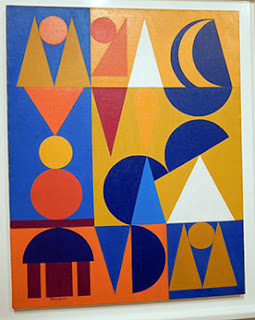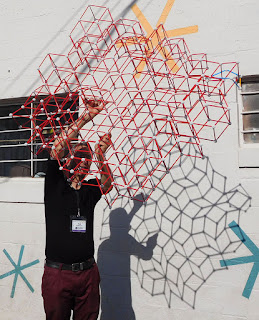We arrived in Greenwich, CT to meet our granddaughter and go to see her in Cabaret, first ever all female production by The Lipstick Project in collaboration with Darien Art Center. While she was finishing her day at school where she teaches, we had some time and looked up what could we visit in Greenwich. I spotted that at Bruce museum there is an exhibit Hot Art in a Cold War: Intersections of Art and Science in Soviet Era. So the point of interest was decided: from train station we headed towards the Bruce museum.
On a hill near museum gates we were greeted by a dinosaur family. How appropriate! At the exhibit first thing I noticed was a portrait of another "dinosaur" - portrait of Brezhnev, leader of the USSR from 1964 until his death in 1982. In this colored pencil picture he is surrounded by flags of 15 Soviet republics.
 |
| Eric Bulatov (b. 1933, worked in Moscow, now lives in Paris) Study for the Soviet Cosmos, 1977 |
There are nearly 40 works produced between 1960 and 1980 by 17 artists from Russia, Ukraine, Estonia, and Latvia. The works on view address a turbulent period marked by the escalating space race and a competition for nuclear supremacy.
As museum guards told me an object that creates the most interest in this exhibit is a backup copy of the original Sputnik first original Earth satellite launched October 4, 1957, event that triggered space race.
Replica of Laika, most famous dog in my childhood. A stray dog from Moscow streets born about the same year I did, was one of the first animals in space, the dog that was sent into orbit soon after Sputnik, November 3, 1957. Pictures of this dog appeared everywhere. On the right side there is a package of cigarettes with Laika on it.
Model of Lunokhod(Moon Rover) - the first remote-controlled robot - a rover that landed on Moon November 1970. These models brought back memories from the time when everything happening in Cosmos was a big event featured on front pages of newspapers, talked about. It was so exciting, it felt that even the most unbelievable dreams can happen. I wonder what event could raise the same excitement these days?Two very simple looking keys. Could you imagine that such keys were essential for launching a missile? These two are replicas of the keys from former Plokstine missile base in Lithuania. Despite their very simple appearance, turning a set of these keys was a critical part of the protocol for launching a missile capable of delivering a warhead over 100 times as powerful as the Hiroshima bomb. These replicas are made from a polished silver, but the actual keys were made from titanium to withstand high voltage levels of the launch system. A similar key with a longer blade was used for the more peaceful purpose of launching space rockets.
 |
| Inārs Helmūts (b. 1934, lives and works in Latvia) Connection from the series Cosmonauts, 1976, etching on paper |
Inārs Helmuts is one of the most outstanding Latvian graphic artists.
 |
| Raul Meel (b.1941, lives and works in Tallinn, Estonia) Under Estonian Sky, 1973, color screen print on paper |
 |
| Petr Belenok (Ukranian, 1938-1991, lived and worked in Moscow) Untitled, mixed media on fiberboard |
 |
| Jānis Borgs (b. 1946, lives and works in Riga, Latvia) Dynamic City, 1976, Gouache and oil pastel on photograph, mounted on plywood |
 |
| Viacheslav Koleichuk (Russian, 1941- April 8, 2018, lived and worked in Moscow) |
Lev Nussberg wrote "Kinetic Manifesto" in which he called for the creation of world institute of kineticism, harnesing an utopian idea of global integration at the height of Cold War. In United States Nussberg has devoted years of promoting Russian suprematists. As an art collector he was involved in multi million lawsuit over 165 frauds.
 |
| Valdis Celms (b. 1943, Lives and works in Riga, Latvia) Positron, 1976, kinetic maquette of steel, paper, and wood |















































































